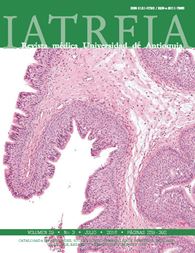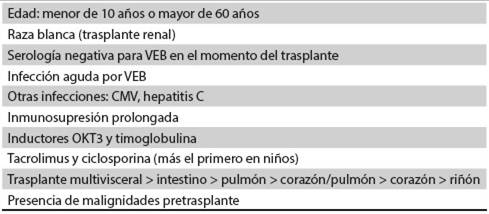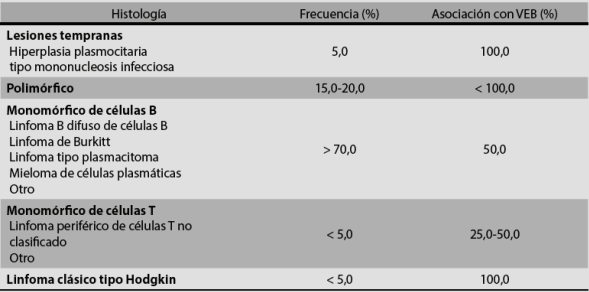Post-transplant lymphoproliferative disease
DOI:
https://doi.org/10.17533/udea.iatreia.v29n3a06Keywords:
Epstein-Barr virus infections, lymphoproliferative disorder, organ transplantationAbstract
Post-transplant lymphoproliferative disease (PTLD) is a group of disorders that may occur after transplantation. Its incidence is variable according to the transplanted organ. The clinical variability of this disease, its extra-nodal involvement and its broad histopathological spectrum make both classification and management very complex. This review provides an update about PTLD in patients with solid organ transplantation.
Downloads
References
(1.) Swerdlow SH, Campo E, Harris NL, Jaffe ES, Pileri SA, Stein H, et al. Posttransplant lymphoproliferative disorders. In: WHO Classification of Tumours of Haematopoietic and Lymphoid Tissues. 4ª ed. Lyon: WHO; 2008. p. 343-50.
(2.) Andreone P, Gramenzi A, Lorenzini S, Biselli M, Cursaro C, Pileri S, et al. Posttransplantation lymphoproliferative disorders. Arch Intern Med. 2003 Sep;163(17):1997-2004.
(3.) Cockfield SM. Identifying the patient at risk for posttransplant lymphoproliferative disorder. Transpl Infect Dis. 2001 Jun;3(2):70-8.
(4.) Al-Mansour Z, Nelson BP, Evens AM. Post-transplant lymphoproliferative disease (PTLD): risk factors, diagnosis, and current treatment strategies. Curr Hematol Malig Rep. 2013 Sep;8(3):173-83. DOI 10.1007/s11899-013-0162-5.
(5.) Zimmermann H, Trappe RU. EBV and posttransplantation lymphoproliferative disease: what to do? Hematology Am Soc Hematol Educ Program. 2013;2013:95-102. DOI 10.1182/asheducation-2013.1.95.
(6.) van Leeuwen MT, Grulich AE, Webster AC, McCredie MR, Stewart JH, McDonald SP, et al. Immunosuppression and other risk factors for early and late non-Hodgkin lymphoma after kidney transplantation. Blood. 2009 Jul;114(3):630-7. DOI 10.1182/blood-2009-02-202507.
(7.) Quinlan SC, Pfeiffer RM, Morton LM, Engels EA. Risk factors for early-onset and late-onset post-transplant lymphoproliferative disorder in kidney recipients in the United States. Am J Hematol. 2011 Feb;86(2):206-9. DOI 10.1002/ajh.21911.
(8.) Caillard S, Lelong C, Pessione F, Moulin B; French PTLD Working Group. Post-transplant lymphoproliferative disorders occurring after renal transplantation in adults: report of 230 cases from the French Registry. Am J Transplant. 2006 Nov;6(11):2735-42.
(9.) Cohen JI. Epstein-Barr virus infection. N Engl J Med. 2000 Aug;343(7):481-92.
(10.) Walker RC, Marshall WF, Strickler JG, Wiesner RH, Velosa JA, Habermann TM, et al. Pretransplantation assessment of the risk of lymphoproliferative disorder. Clin Infect Dis. 1995 May;20(5):1346-53.
(11.) Mañez R, Breinig MC, Linden P, Wilson J, Torre-Cisneros J, Kusne S, et al. Posttransplant lymphoproliferative disease in primary Epstein-Barr virus infection after liver transplantation: the role of cytomegalovirus disease. J Infect Dis. 1997 Dec;176(6):1462-7.
(12.) Hézode C, Duvoux C, Germanidis G, Roudot-Thoraval F, Vincens AL, Gaulard P, et al. Role of hepatitis C virus in lymphoproliferative disorders after liver transplantation. Hepatology. 1999 Sep;30(3):775-8.
(13.) Khedmat H, Taheri S. Hepatitis C virus infection can affect lymphoproliferative disorders only as a cofactor for Epstein-Barr virus in liver transplant recipients: PTLD.Int survey. Exp Clin Transplant. 2012 Apr;10(2):141-7.
(14.) Penn I, Hammond W, Brettschneider L, Starzl TE. Malignant lymphomas in transplantation patients. Transplant Proc. 1969 Mar;1(1):106-12.
(15.) Shapiro R, Nalesnik M, McCauley J, Fedorek S, Jordan ML, Scantlebury VP, et al. Posttransplant lymphoproliferative disorders in adult and pediatric renal transplant patients receiving tacrolimusbased immunosuppression. Transplantation. 1999 Dec;68(12):1851-4.
(16.) Dharnidharka VR, Sullivan EK, Stablein DM, Tejani AH, Harmon WE; North American Pediatric Renal factors for posttransplant lymphoproliferative disorder (PTLD) in pediatric kidney transplantation: a report of the North American Pediatric Renal Transplant Cooperative Study (NAPRTCS). Transplantation. 2001 Apr;71(8):1065-8.
(17.) Caillard S, Dharnidharka V, Agodoa L, Bohen E, Abbott K. Posttransplant lymphoproliferative disorders after renal transplantation in the United States in era of modern immunosuppression. Transplantation. 2005 Nov;80(9):1233-43.
(18.) Funch DP, Ko HH, Travasso J, Brady J, Kew CE 2nd, Nalesnik MA, et al. Posttransplant lymphoproliferative disorder among renal transplant patients in relation to the use of mycophenolate mofetil. Transplantation. 2005 Nov;80(9):1174-80.
(19.) Robson R, Cecka JM, Opelz G, Budde M, Sacks S. Prospective registry-based observational cohort study of the long-term risk of malignancies in renal transplant patients treated with mycophenolate mofetil. Am J Transplant. 2005 dec;5(12):2954-60.
(20.) Vincenti F, Charpentier B, Vanrenterghem Y, Rostaing L, Bresnahan B, Darji P, et al. A phase III study of belatacept-based immunosuppression regimens versus cyclosporine in renal transplant recipients (BENEFIT study). Am J Transplant. 2010 Mar;10(3):535-46. DOI 10.1111/j.1600-6143.2009.03005.x.
(21.) Nieto-Ríos JF, Aristizabal-Alzate A, Ocampo-Kohn C, Vanegas-Ruiz JJ, Velez-Echeverri C, Serna-Higuita LM, et al. Baja incidencia de enfermedad linfoproliferativa Postrasplante renal con uso predominante de Alemtuzumab. Rev Nefrol Dial Transpl. 2014 Mar;34(1):21-6.
(22.) Opelz G, Döhler B. Lymphomas after solid organ transplantation: a collaborative transplant study report. Am J Transplant. 2004 Feb;4(2):222-30.
(23.) Végso G, Hajdu M, Sebestyén A. Lymphoproliferative disorders after solid organ transplantationclassification, incidence, risk factors, early detection and treatment options. Pathol Oncol Res. 2011 Sep;17(3):443-54. DOI 10.1007/s12253-010-9329-8.
(24.) Taylor AL, Marcus R, Bradley JA. Post-transplant lymphoproliferative disorders (PTLD) after solid organ transplantation. Crit Rev Oncol Hematol. 2005 Oct;56(1):155-67.
(25.) Shroff R, Rees L. The post-transplant lymphoproliferative disorder-a literature review. Pediatr Nephrol. 2004 Apr;19(4):369-77.
(26.) Jagadeesh D, Woda BA, Draper J, Evens AM. Post transplant lymphoproliferative disorders: risk, classification, and therapeutic recommendations. Curr Treat Options Oncol. 2012 Mar;13(1):122-36. DOI 10.1007/s11864-011-0177-x.
(27.) Buell JF, Gross TG, Hanaway MJ, Trofe J, Roy-Chaudhury P, First MR, et al. Posttransplant lymphoproliferative disorder: significance of central nervous system involvement. Transplant Proc. 2005 Mar;37(2):954-5.
(28.) Parker A, Bowles K, Bradley JA, Emery V, Featherstone C, Gupte G, et al. Management of post-transplant lymphoproliferative disorder in adult solid organ transplant recipients - BCSH and BTS Guidelines. Br J Haematol. 2010 Jun;149(5):693-705. DOI 10.1111/j.1365-2141.2010.08160.x.
(29.) Bianchi E, Pascual M, Nicod M, Delaloye AB, Duchosal MA. Clinical usefulness of FDG-PET/CT scan imaging in the management of posttransplant lymphoproliferative disease. Transplantation. 2008 Mar;85(5):707-12. DOI 10.1097/TP.0b013e3181661676.
(30.) Carbone PP, Kaplan HS, Musshoff K, Smithers DW, Tubiana M. Report of the Committee on Hodgkin’s Disease Staging Classification. Cancer Res. 1971 Nov;31(11):1860-1.
(31.) Stevens SJ, Verschuuren EA, Pronk I, van Der Bij W, Harmsen MC, The TH, et al. Frequent monitoring of Epstein-Barr virus DNA load in unfractionated whole blood is essential for early detection of posttransplant lymphoproliferative disease in high-risk patients. Blood. 2001 Mar;97(5):1165-71.
(32.) Lee TC, Savoldo B, Rooney CM, Heslop HE, Gee AP, Caldwell Y, et al. Quantitative EBV viral loads and immunosuppression alterations can decrease PTLD incidence in pediatric liver transplant recipients. Am J Transplant. 2005 Sep;5(9):2222-8.
(33.) Choquet S, Varnous S, Deback C, Golmard JL, Leblond V. Adapted treatment of Epstein-Barr virus infection to prevent posttransplant lymphoproliferative disorder after heart transplantation. Am J Transplant. 2014 Apr;14(4):857-66. DOI 10.1111/ajt.12640.
(34.) San-Juan R, Manuel O, Hirsch HH, Fernández-Ruiz M, López-Medrano F, Comoli P, et al. Current preventive strategies and management of Epstein–Barr virus-related post-transplant lymphoproliferative disease in solid organ transplantation in Europe. Results of the ESGICH Questionnaire-based Cross-sectional Survey. Clin Microbiol Infect [Internet]. 2015 Jun. [cited 2015 Abr 15];21(6):[604.e1–604.e9]. Available from: http://linkinghub.elsevier.com/retrieve/pii/S1198743X15002888
(35.) Zimmermann H, Trappe RU. Therapeutic options in post-transplant lymphoproliferative disorders. Ther Adv Hematol. 2011 Dec;2(6):393-407. DOI 10.1177/2040620711412417.
(36.) Reshef R, Vardhanabhuti S, Luskin MR, Heitjan DF, Hadjiliadis D, Goral S, et al. Reduction of immunosuppression as initial therapy for posttransplantation lymphoproliferative disorder. Am J Transplant. 2011 Feb;11(2):336-47. DOI 10.1111/j.1600-6143.2010.03387.x.
(37.) Paya CV, Fung JJ, Nalesnik MA, Kieff E, Green M, Gores G, et al. Epstein-Barr virus-induced posttransplant lymphoproliferative disorders. ASTS/ASTP EBV-PTLD Task Force and The Mayo Clinic Organized International Consensus Development Meeting. Transplantation. 1999 Nov;68(10):1517-25.
(38.) Oertel SH, Verschuuren E, Reinke P, Zeidler K, Papp-Váry M, Babel N, et al. Effect of anti-CD 20 antibody rituximab in patients with post-transplant lymphoproliferative disorder (PTLD). Am J Transplant. 2005 Dec;5(12):2901-6.
(39.) Choquet S, Leblond V, Herbrecht R, Socié G, Stoppa AM, Vandenberghe P, et al. Efficacy and safety of rituximab in B-cell post-transplantation lymphoproliferative disorders: results of a prospective multicenter phase 2 study. Blood. 2006 Apr;107(8):3053-7.
(40.) Oertel SH, Papp-Váry M, Anagnostopoulos I, Hummel MW, Jonas S, Riess HB. Salvage chemotherapy for refractory or relapsed post-transplant lymphoproliferative disorder in patients after solid organ transplantation with a combination of carboplatin and etoposide. Br J Haematol. 2003 Dec;123(5):830-5.
(41.) Monaco AP. The role of mTOR inhibitors in the management of posttransplant malignancy. Transplantation. 2009 Jan;87(2):157-63. DOI 10.1097/TP.0b013e318193886e.
(42.) Majewski M, Korecka M, Kossev P, Li S, Goldman J, Moore J, et al. The immunosuppressive macrolide RAD inhibits growth of human Epstein-Barr virustransformed B lymphocytes in vitro and in vivo: A potential approach to prevention and treatment of posttransplant lymphoproliferative disorders. Proc Natl Acad Sci U S A. 2000 Apr;97(8):4285-90.
(43.) Majewski M, Korecka M, Joergensen J, Fields L, Kossev P, Schuler W, et al. Immunosuppressive TOR kinase inhibitor everolimus (RAD) suppresses growth of cells derived from posttransplant lymphoproliferative disorder at allograft-protecting doses. Transplantation. 2003 May;75(10):1710-7.
(44.) Pascual J. Post-transplant lymphoproliferative disorder--the potential of proliferation signal inhibitors. Nephrol Dial Transplant. 2007 May;22 Suppl 1:i27-35.
(45.) Evens AM, Choquet S, Kroll-Desrosiers AR, Jagadeesh D, Smith SM, Morschhauser F, et al. Primary CNS posttransplant lymphoproliferative disease (PTLD): an international report of 84 cases in the modern era. Am J Transplant. 2013 Jun;13(6):1512-22. DOI 10.1111/ajt.12211.
(46.) Trappe R, Zimmermann H, Fink S, Reinke P, Dreyling M, Pascher A, et al. Plasmacytoma-like post-transplant lymphoproliferative disorder, a rare subtype of monomorphic B-cell post-transplant lymphoproliferation, is associated with a favorable outcome in localized as well as in advanced disease: a prospective analysis of 8 cases. Haematologica. 2011 Jul;96(7):1067-71. DOI 10.3324/haematol.2010.039214.
(47.) Karuturi M, Shah N, Frank D, Fasan O, Reshef R, Ahya VN, et al. Plasmacytic post-transplant lymphoproliferative disorder: a case series of nine patients. Transpl Int. 2013 Jun;26(6):616-22. DOI 10.1111/tri.12091.
(48.) Bierman PJ, Vose JM, Langnas AN, Rifkin RM, Hauke RJ, Smir BN, et al. Hodgkin’s disease following solid organ transplantation. Ann Oncol. 1996 Mar;7(3):265-70.
(49.) Garnier JL, Lebranchu Y, Dantal J, Bedrossian J, Cahen R, Assouline D, et al. Hodgkin’s disease after transplantation. Transplantation. 1996 Jan;61(1):71-6.
(50.) Leblond V, Dhedin N, Mamzer Bruneel MF, Choquet S, Hermine O, Porcher R, et al. Identification of prognostic factors in 61 patients with posttransplantation lymphoproliferative disorders. J Clin Oncol. 2001 Feb;19(3):772-8.
(51.) Ghobrial IM, Habermann TM, Maurer MJ, Geyer SM, Ristow KM, Larson TS, et al. Prognostic analysis for survival in adult solid organ transplant recipients with post-transplantation lymphoproliferative disorders. J Clin Oncol. 2005 Oct;23(30):7574-82.
(52.) Evens AM, David KA, Helenowski I, Nelson B, Kaufman D, Kircher SM, et al. Multicenter analysis of 80 solid organ transplantation recipients with posttransplantation lymphoproliferative disease: outcomes and prognostic factors in the modern era. J Clin Oncol. 2010 Feb;28(6):1038-46. DOI 10.1200/JCO.2009.25.4961.
Published
How to Cite
Issue
Section
License
Copyright (c) 2016 Iatreia

This work is licensed under a Creative Commons Attribution-ShareAlike 4.0 International License.
Papers published in the journal are available for use under the Creative Commons license, specifically Attribution-NonCommercial-ShareAlike 4.0 International.
The papers must be unpublished and sent exclusively to the Journal Iatreia; the author uploading the contribution is required to submit two fully completed formats: article submission and authorship responsibility.
















